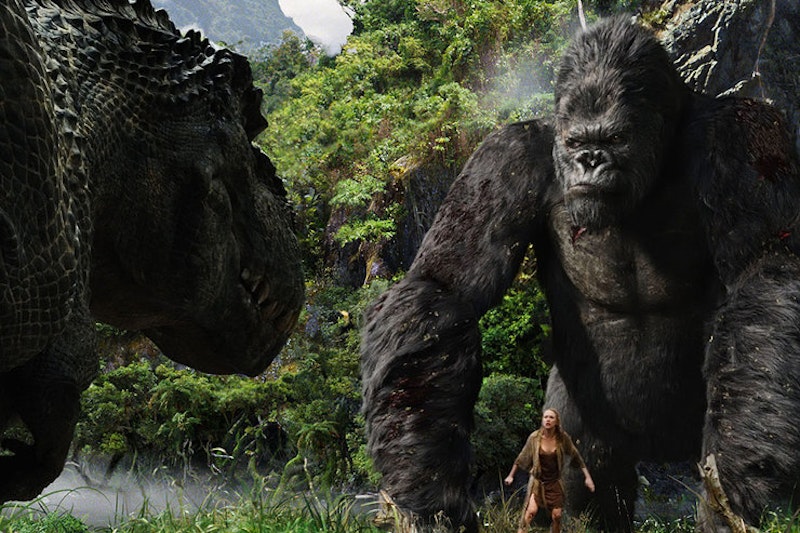Kong: Skull Island devotes much of its running time to an obvious political allegory, while taking its setting from the least interesting aspect of every previous King Kong film. Still, it adds up to a generally satisfying action film, from a young director who knows what he’s doing. Skull Island is directed by Jordan Vogt-Roberts, whose only previous directing credit (besides a Nick Offerman standup special) was 2013’s winning indie comedy/drama The Kings of Summer, the one about three teenage boys who go and live in a clubhouse in the woods.
That would appear to serve as little preparation for a production of this size, although Vogt-Roberts shows a superlative sense of pacing and space, clearly establishing the geography of the island and constructing setups that pay off down the line. This redeems some of the film’s flaws.
Kong: Skull Island is the second in a planned “Monsterverse” that shares a universe with the 2014 Godzilla, and much like that movie—also directed by an indie veteran (Gareth Edwards)—Kong overcomes iffy execution with a great action finale, and a depiction of the titular monster that’s much better rendered than most of the human characters. The film combines an impressive cast (led by Samuel L. Jackson, John Goodman, John C. Reilly, Tom Hiddleston, and Brie Larson) with perhaps the most unorthodox telling of the Kong mythology to date: the film is set entirely in 1973, on Kong’s native Skull Island. There’s no Empire State Building, no “’twas beauty killed the beast.” Kong doesn’t even leave the island.
Skull Island, in fact, was probably the least interesting aspect of every previous Kong film, especially Peter Jackson’s 2005 effort, in which the entire middle hour put the plot of the film on pause to, in true Jackson fashion, show different CGI creatures fighting each other.
There’s a reason for the setting of the new movie, and not only that Kong is needed for future films, including an eventual face-off with Godzilla. Skull Island’s plot is an elaborately constructed allegory about the Vietnam War and U.S. involvement in it. The soldiers have invaded a jungle island in the South Pacific where there’s a long-term battle going on that they have nothing to do with, but they’ve arrived and made it worse. Kong might as well have been spelled “Cong.”
There are Platoon and Apocalypse Now references everywhere, and the film wholeheartedly embraces several of the Vietnam clichés so thoroughly sent up in Tropic Thunder almost 10 years ago, starting with era-specific musical cues. But the film never quite follows its allegory to any logical conclusion. So Skull Island, for a lot of reasons, shouldn’t work—until, suddenly, it does. And that’s thanks to a brilliantly blocked final battle and the way the plot resolves itself.
The setup is it’s the Paris Peace Accords and the U.S. has agreed to withdraw from Vietnam. At the same time, crackpot scientist John Goodman is pushing for government funding to explore his theory that monsters live beneath the earth. He and his partner (current 24 star Corey Hawkins) go to Skull Island, escorted with a military unit (led by Samuel L. Jackson) on one more mission before heading home. Also in the mix are a British soldier of fortune type (Tom Hiddleston) and a hippie-ish war photographer (Brie Larson). They head to Skull Island, where they meet the titular Kong and a coterie of otherworldly CGI’d creatures, from giant sea monsters to trees that eat people. When it comes to the CGI, Kong is a wonder.
Hiddleston and Larson are the romantic leads, and they’re fine, if obviously slumming in a March-released summer blockbuster. But walking away with the movie is John C. Reilly, sporting a Cast Away beard as a soldier who’d been left on the island since World War II. He starts as a character in the model of Dennis Hopper in Apocalypse Now, but turns on a surprisingly amount of pathos by the end.
Against the tradition of the 2014 Godzilla when Bryan Cranston died pretty early, characters seem to get offed in inverse order of how famous the actor is, and one character in particular gets one of the most undignified on-camera deaths I’ve ever seen in a blockbuster film. He dies, none of the other characters seem to care, and when they meet up with a separate group a few minutes later and tell them, “we lost a man,” none of them cares enough to ask who it was.
Like a lot of movies with Chinese co-financing, Skull Island takes a pair of Chinese actors (Tian Jing and Miyavi) who are popular in Asia, puts them on screen for the majority of the film, but doesn’t let either of them figure in the plot in the slightest way (one of them has two or three lines, the other none). I get that this is a gesture towards the box office in Asia, but the cynicism is so transparent that you’d think one billion Chinese would’ve stopped falling for that trick by now.

